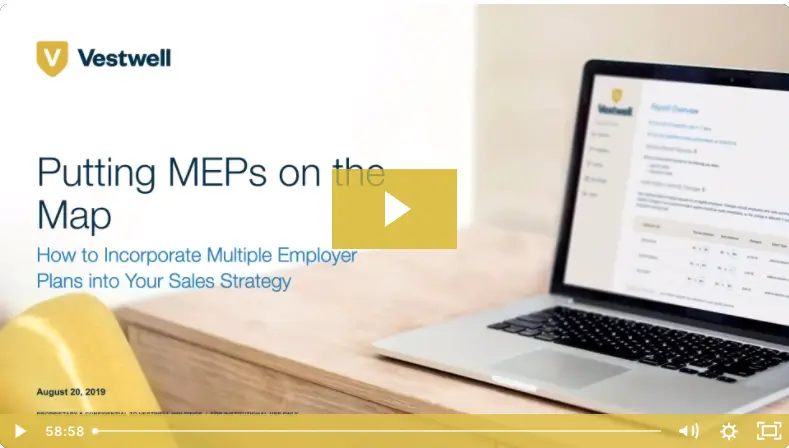
Putting MEPs on the Map: How to Incorporate Multiple Employer Plans (MEPs) into Your Sales Strategy
MEP Final Rule – What Changed and What's On the Horizon?
Historical Definition of a MEP
The Department of Labor (DOL) has historically required an employer group or association to be “bona fide” in order to sponsor a workplace retirement plan. Previously, this meant the group must:
- Exercise control over the plan amendment process, plan termination, and other similar functions of the plan on behalf of the participating employer members and;
- Pass the “Commonality Test” by having related interests, such as being part of the same industry.
How the Definition Has Changed
- Changes to who is “bona fide." - The DOL’s Final Rule now makes it easier for “bona fide” employer groups and associations and Professional Employer Organizations (PEOs) to pass the “Commonality Test,” and therefore easier to form a MEP (ex. employers that are only connected by their geographic location now satisfy the Commonality Test.)
- New rules for defining “Working Owners” -
- Sole proprietors and other self-employed individuals are now considered both an employer and employee and can therefore be participating employers in a MEP. However, this ruling only extends to MEPs offered by an employer group or organization, and not MEPs sponsored by a PEO.
- There are rules surrounding a working owner’s hours and income as well. In order to participate in the MEP, they must work at least 20 hours per week, 80 hours per month, or have wages or self-employment income that at least equals the cost of his or her participation and the participation of his or her employees in any group health plan sponsored by the group or association.
- Changes affect closed MEPs Only - The Final Rule only applies to closed MEPs. There is pending legislation called the SECURE Act and RESA that allow “open MEPs” to exist. In an “open MEP,” employers do not need to have any connection to each other;in other words, the Commonality Test is irrelevant. The tradeoff, though, is that each employer in an open MEP must still file its own Form 5500, obtain its own ERISA bond, and obtain a separate audit (for plans with more than 100 participants).
What Does It Mean to Be "Bona-Fide?"
In order for a group or association to be considered “bona fide,” it must meet three requirements:
- Substantial business purpose - The group or association must have at least one substantial business purpose apart from providing employee benefits. For example, many chambers of commerce or trade associations offer education resources and group discounts to members which will likely be a strong enough argument to satisfy this requirement.
- Participating employer control over group or association - The employer needs to have some level of control over the group, such as by nominating directors, officers, trustees; having authority to remove any of them; and having the ability to approve or veto decisions relating to the formation, design, amendment and termination of the plan.
- Commonality Test - As mentioned above, closed MEPs require “commonality of interest” among the participating employers. Connection among them due to their industry or, now with the final ruling, geographic location will suffice.
Key Tips for Advisors Working with Closed MEPs
Responsibilities of Lead Employer vs. Participating Employers
There are two types of employers in a closed MEP, a Lead Employer (LE) and one or more Participating Employers (PE). Generally, the LE serves as plan administrator with overall responsibility for operating the MEP in accordance with ERISA’s fiduciary rules, such as selecting the fund line-up and service providers. PEs must carefully select and monitor the LE and get periodic reports regarding its administration of the MEP.
Takeaway Tips for Advisors:
- Since chambers of commerce and trade associations may not have expertise in fiduciary matters, advisors can help by educating them about their fiduciary duties. Use Vestwell’s plan governance toolkit for ready-to-use templates and tools to educate your clients.
- Another key risk mitigation strategy is to help your clients retain qualified service providers.
- Advisors and all plan fiduciaries should have sufficient insurance. ERISA bonds are required, but are different than fiduciary insurance.
“One Bad Apple” Rule
The qualification failures of one participating employer could taint the qualified status of the plan for all other participating employers. The IRS issued a proposed regulation in July that would remove the taint if certain requirements are met. Generally, the employees of the offending participating employer are protected from adverse tax consequences under the proposed regulation. It is worth noting that the proposed regulation may not be relied upon until and unless it is finalized.
Takeaway Tips for Advisors:
- The LE will be responsible for notifying the offending PE and either require correction of qualification failure(s) or spin off the offending PE’s plan assets out of the MEP. Advisors can educate LEs and PEs about their compliance requirements to prevent problems in the first place.
- Advisors should carefully review the plan documents and the joinder agreement. Those are the key materials that spell out the rights of all PEs, including whether they can tailor any plan features, like vesting schedules, to their own workforce. And the joinder agreement explains how the PE can withdraw from the MEP if it turns out not to be a good fit.
How MEPs Can Fit Into Your Sales Strategy
MEPs can be a great way to help certain types of companies provide efficient retirement benefits. However, there are some opportunities that allow for economies of scale while others may lead to more work in the long run.
Leverage Technology That Allows for Scale
One potential challenge with closed MEPs is that the use of differ- ent payroll providers can lead to logistical issues. Different providers means different formats and data types among payroll files. Since accurate payroll files are critical to administering the plan, some MEPs engage a separate data aggregator to process those files which adds time and cost while making the plan more vulnerable to mistakes. Con- sider a platform for the MEP that unitizes all of the disparate payroll file formats (without having to engage – and pay for – a separate data aggregator).
Find the Right Opportunities:
- PEO’s and Trade Associations - MEPs are very efficient when there are synergies between businesses, such as the same payroll provider, employee demographics, or industry.
- Smaller or starter plans - MEPs are usually a good fit for starter or smaller plans that do not need customization. Owners that want a simple, outsourced fiduciary structure are well suited for a MEP.
- Local and state business associations - These may be a good fit for a MEP, but advisors should look for organizations that have the membership size to ensure the MEP will reap cost and service efficiencies.
- Plans that don’t need customization - MEPs are not recommended for plans that want to customize plan design and investments or plan to in the future. If plans do need customization, there are ways to offer them what they need at similar costs to a MEP if you go about it the right way.
Show Associations How They Benefit
MEPs can be leveraged by groups to show good will and name recognition. Communicate to associations how offering a retirement plan to their employees is not only a benefit for their brand but also a streamlined solution for all employers. Best of all, the advisor handles the rest - 3(38), education, and/or enrollment services with a bundled provider to perform all remaining recordkeeping, plan administration, and fiduciary support. All service providers can receive a fee which should be disclosed to all PEs and participants.
The MEP story is still evolving, but if you are in the small plan market - or looking to get into it - now is the time to begin exploring options for you and your clients. Because once MEPs are on the map, there will be no looking back.








